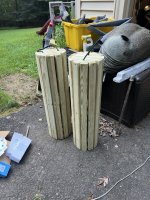Steve Sanford
Well-known member
Dave Diefenderfer et al~
Here are some beach rollers - like ones that I have used as long as I can remember. My Dad mostly used them for launching his Great South Bay Ice Scooter off the beach and onto the half-frozen bay, but I have used them many times where there was no ramp and for simply moving vessels around the yard - and even for short-term storage when a boat is off its trailer.
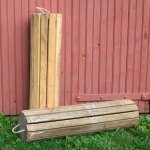
They are very simple and straightforward to make. Cedar - White or Red - is the traditional choice, but White Pine will work, too. Treated lumber is heavier than you need - but can be used as well. I have used Cypress but can no longer get it hereabouts. I make mine about 36-inches long but have made them up to 48 inches for beamier craft. The lumber need not be perfectly clear - but must be free of any large structural knots or those that might fall out.
There are 2 ends and a single support in the middle. Each is a dodecagon - a 12-sided regular polygon. If you print this full-size on 8.5x11 paper (card stock is ideal) then you have the pattern. Saw 3 of these from 5/4x8 Cedar or Pine - saw 6 for a pair of rollers.
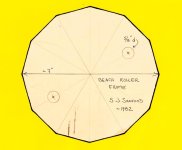
After ripping 24 ( one dozen for each roller) slats on the table saw, assembly is quick and easy.
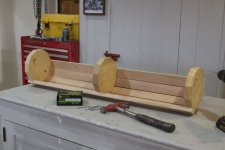
Each slat gets fastened with nails - galvanized box or decking nails are fine - or fine (#7) deck screws. I fasten each slat dry, i.e., no adhesive or caulk.
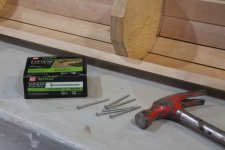
Note that the slats are not tight to one another. The gaps allow water and sand to flow freely in and out.
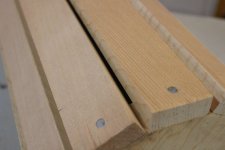
In recent years, I make sure at least one slat is screwed so that I can remove it to replace the rope "handles" if needed.
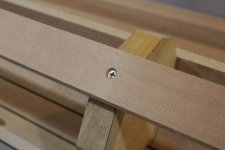
Phillips head (or even slotted) are handy - because you can always find the right tip to remove them when needed.
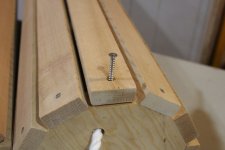
I use 3/8 or 1/2-inch line for the handles. You can put a figure-8 knot in each end - or tie the ends together with a square knot (aka reef knot for you sailors...) inside the roller.
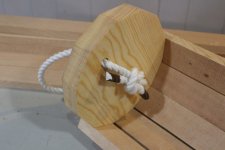
Manila or hemp are nice and traditional - but I use a synthetic nowadays for durability.
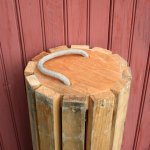
Similar rollers can be made from PVC pipe - and inflatable rollers are available. The relatively large (~ 9 inch) diameter of these wooden beach rollers helps them to negotiate soft sand or mud. Wooden rollers with rope handles float and can be easily grabbed.
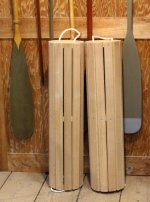
To use them for long distances - more than just from the trailer to the water - I leap-frog the rollers, always keeping one about amidships so the bow or stern bear almost no weight and the second roller can be moved forward as it rolls out of the stern. We have rolled duckboats hundreds of feet this way when we had to. When we have moved much larger vessels, we use a set of 3 rollers so the boat never needs to be lifted.
BTW: When traveling to and from a hunt, the rollers can ride in the back of a pickup. My Dad made a set of 4 brackets so that the rollers can ride either side of the trailer tongue. I still have the brackets and may mount them someday....
Hope this helps!
SJS
Here are some beach rollers - like ones that I have used as long as I can remember. My Dad mostly used them for launching his Great South Bay Ice Scooter off the beach and onto the half-frozen bay, but I have used them many times where there was no ramp and for simply moving vessels around the yard - and even for short-term storage when a boat is off its trailer.

They are very simple and straightforward to make. Cedar - White or Red - is the traditional choice, but White Pine will work, too. Treated lumber is heavier than you need - but can be used as well. I have used Cypress but can no longer get it hereabouts. I make mine about 36-inches long but have made them up to 48 inches for beamier craft. The lumber need not be perfectly clear - but must be free of any large structural knots or those that might fall out.
There are 2 ends and a single support in the middle. Each is a dodecagon - a 12-sided regular polygon. If you print this full-size on 8.5x11 paper (card stock is ideal) then you have the pattern. Saw 3 of these from 5/4x8 Cedar or Pine - saw 6 for a pair of rollers.

After ripping 24 ( one dozen for each roller) slats on the table saw, assembly is quick and easy.

Each slat gets fastened with nails - galvanized box or decking nails are fine - or fine (#7) deck screws. I fasten each slat dry, i.e., no adhesive or caulk.

Note that the slats are not tight to one another. The gaps allow water and sand to flow freely in and out.

In recent years, I make sure at least one slat is screwed so that I can remove it to replace the rope "handles" if needed.

Phillips head (or even slotted) are handy - because you can always find the right tip to remove them when needed.

I use 3/8 or 1/2-inch line for the handles. You can put a figure-8 knot in each end - or tie the ends together with a square knot (aka reef knot for you sailors...) inside the roller.

Manila or hemp are nice and traditional - but I use a synthetic nowadays for durability.

Similar rollers can be made from PVC pipe - and inflatable rollers are available. The relatively large (~ 9 inch) diameter of these wooden beach rollers helps them to negotiate soft sand or mud. Wooden rollers with rope handles float and can be easily grabbed.

To use them for long distances - more than just from the trailer to the water - I leap-frog the rollers, always keeping one about amidships so the bow or stern bear almost no weight and the second roller can be moved forward as it rolls out of the stern. We have rolled duckboats hundreds of feet this way when we had to. When we have moved much larger vessels, we use a set of 3 rollers so the boat never needs to be lifted.
BTW: When traveling to and from a hunt, the rollers can ride in the back of a pickup. My Dad made a set of 4 brackets so that the rollers can ride either side of the trailer tongue. I still have the brackets and may mount them someday....
Hope this helps!
SJS


